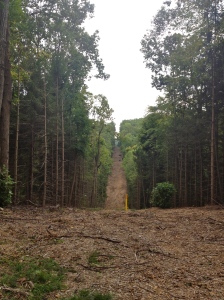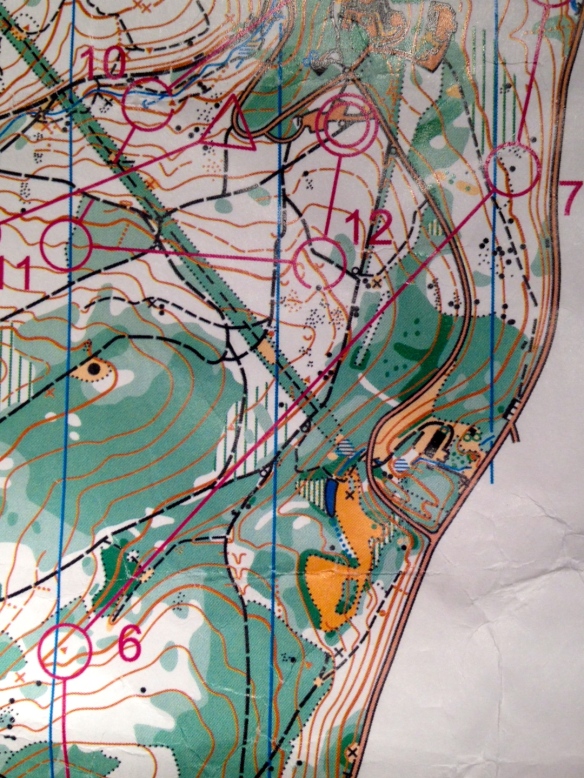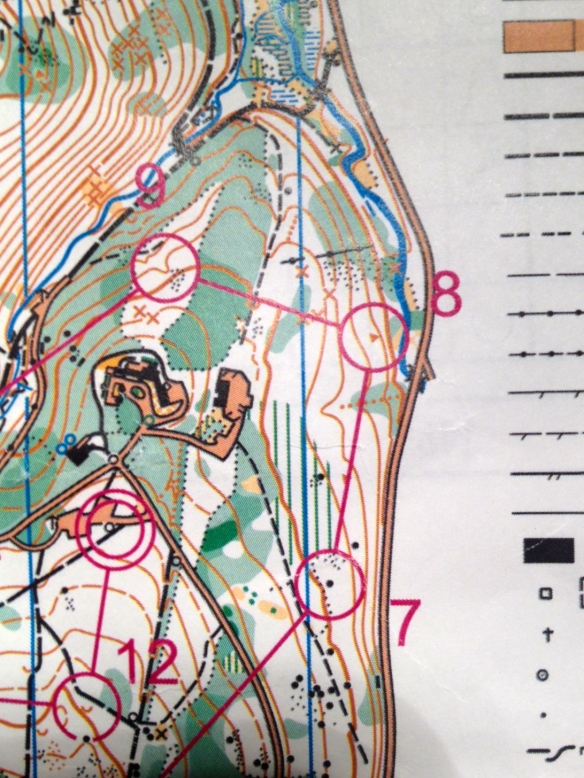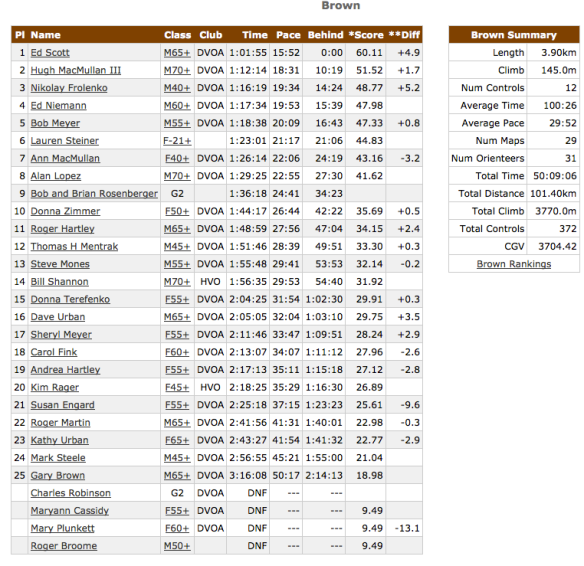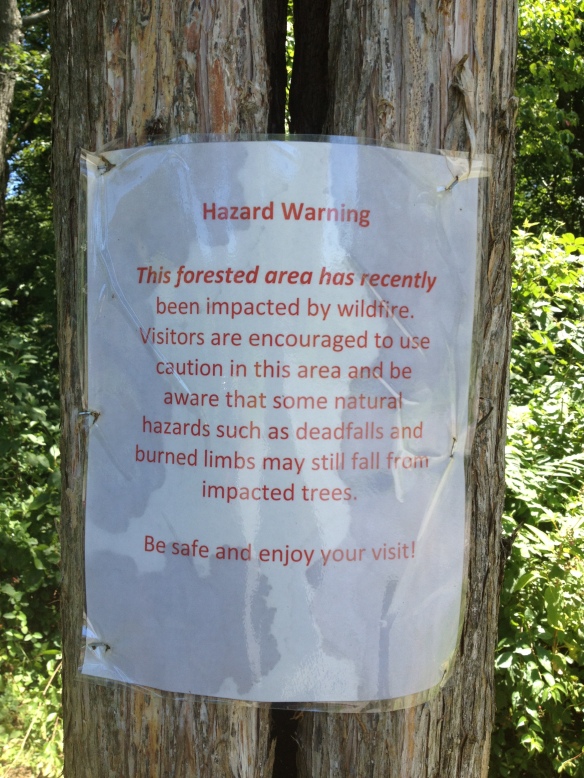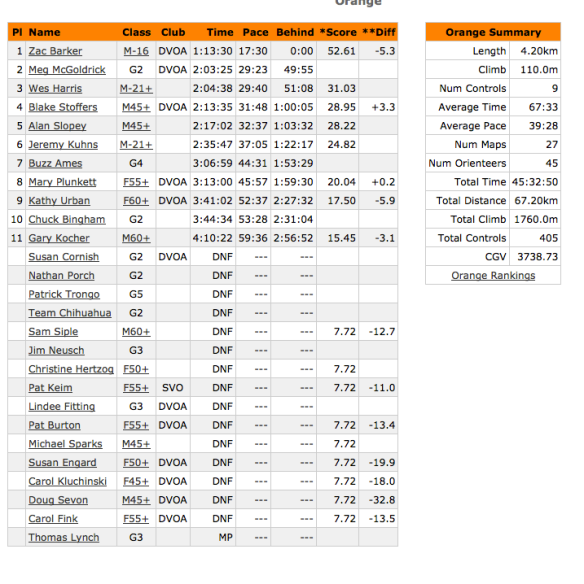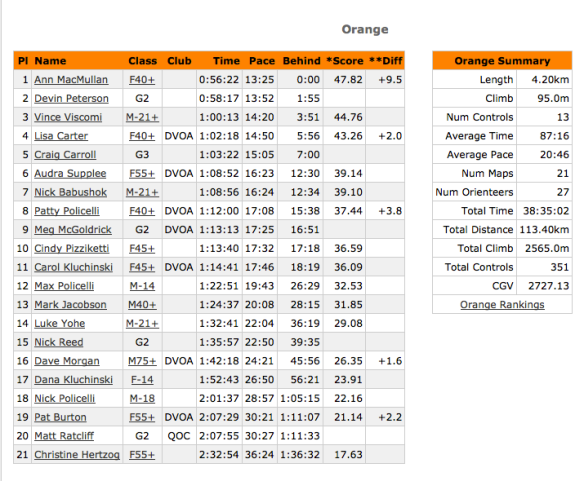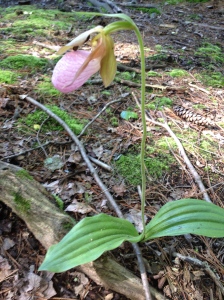Yeah! First Brown Course! Didn’t do too badly! (Except for those 2 controls…) I figured that Nolde would be a good place to try Brown since there is a good trail system to catch you if you mess up. The Ahlswedes and Speedy also convinced me to go for it, saying if I had successfully completed an Orange at Hickory Run I could manage this. Plus I think I’ve just been itching to have that Hickory Run feeling back, where I was just going through the woods and landing where I wanted, with not many linear features to navigate by. It’s a very different feeling than being on trails, and I’m new to it, I’m just starting to understand what advanced Orienteering can be (a lot of bashing through stuff!! and careful compass use! and pace counting! and just knowing.)
It was a typical Sunday O-morning: put on the fastest pants possible, pack up a cooler with sandwiches made the night before, eat my hardboiled egg and swiss sandwich, drink my tea while driving and navigating and playing music (and thus slightly annoying my co-pilot, whose multitasking skills are not quite as facile as mine,) get to the location, eat a banana, get more nervous, talk to the course setter about what to look out for, register, saying hi to those who are becoming my DVOA pals, change into the complete outfit, put on my implements – fingerstick, compass…oh, but this time, instead of holding my clue sheet in my right hand, I had some help setting up a slightly different system from Vadim. He taped the clue sheet with clear tape on both sides, and I fastened it to my shirt with a safety pin so I could pull it up and read when needed. Neat trick which I will use again, for sure. 🙂
Dad went out first, and I waited a while before leaving so as not to run into him. Once again, at the start, I noticed people on my course and the direction they chose. I had my compass aligned to North and when I flipped over the map, I was oriented right away, and off I went to Numero Uno.
Taking trails to the North of the control, I wanted to start to make my way into the woods at the vegetation boundary, but I wasn’t really sure what I was looking at, so I took a bearing towards the control at the path junction by the stream and found it – though the feature, a subtle re-entrant, was not easy to see. I saw the control before I saw the feature. Number 2 I was a little more unsure of myself, deciding at first to follow my compass bearing, and then changing my course and going lower towards the stream to use it as a feature to navigate by. Pace counting the whole way, I came to the marshy area below the boulder and started up there, not seeing the boulder right away, but then finally spotting it. 2 to 3 was a trek up the hill, with the plan to use the trail system and go a little faster to go around. I was really pointing in the exact right spot, because when I got to the trail running E to W, there was the smaller connector trail running N/S. Went around on the trail system and pace counted from the junction to parallel of the control, and made my way in, seeing that it was quite dark green in there and praying that I found the control – which I did, I was only a tiny bit away from it. Gave the location away to another orienteer here.
3 to 4 I just wanted to hurry and get away from the other orienteer! So I didn’t take my time to set a bearing and feel solid with it…and I ended up way too east of the boulders, and felt that I was off – gave up quickly and kept going to the trail, went west to the trail junction and back North towards 4 and got it. 4 to 5 was clean, took a bearing, it got a little sticky in there, and then I came crashing out of the woods to try and get away from other orienteers. This is apparently my downfall, and I need to not worry about them and just be thinking about what I’m doing, because I went crashing out, with the idea that I was going to take the trail system around and to the North of 6, but I took the first trail west instead of east, realized I screwed up, bailing and going in past number 4 through woods, and really running like a totally crazy wild woman. It kind of felt good, but I knew I was messing up bigtime and I guess I was thinking, just go faster to make up for the mistake. Uh oh. Okay, got to the North trail and was planning on navigating in to the feature/control by using the first ditch…but guess what, I totally missed seeing the first and second ditches and thought I was taking the first ditch but instead was following an overgrown path to a small clearing. I knew the contours felt right, that I was at the bottom, and thought it should be to my left when in fact it was very far to my right, or to the west. I flailed around in there for a while, really almost crying, just being lost and not knowing how to redirect. People passing made me think I was reading the contours wrong and I went up the hill a bit. Then I thought I figured it out – but was not confident, I mean up was down at this point for me – and asked a passing older gent to confirm my location – just saying, “Am I right here?” pointing to the map. Lucky he was a nice guy and he said “yes, you are not far away. Keep at it.” Finally made it to the right spot. I was so relieved to find this control I almost wanted to kiss it! I think taking a compass bearing through woods would have been a much better bet in retrospect – especially considering that the dark green is actually passable pine forest – the thing I was trying to avoid all along. ARG.
6 to 7, I kicked in some running to make up time. Took trails to the road and pace counted from the vegetation boundary, started looking for the trail. Realized that this too, was an overgrown trail, and recognized the newer plants there – the stilt grass coming up. Followed along the “trail” and came across the older gent who I’d seen at number 6, he was confused by the lack of trail and I pointed out where I thought it was. What is going on – this is not a team sport, you’re thinking! 🙂 We got to the boulder around the same time.
7 to 8, the plan was to go east of the undergrowth but not too far down, but there were so many downed trees, I had to almost go to the road. Plus I could see footsteps from other orienteers. Gosh I felt like a tracker when I noticed that. 🙂 Got to the ditch, which was hard to physically get through, jumped down to the stream level, and then headed back up, using my compass. I should have really thought this through a bit more, because seeing level ground (the charcoal terrace control) from below is way more difficult! And a waste of effort to go down and then up again. But luckily my bearing was good and I walked right to it. Feeling confident with my compass now, I took a bearing to number 9 and went through the worst vegetation of the whole course. It was like a bad dream where you can’t move in here, bash bash bash, stomp stomp stomp. I am one of the creatures from Where the Wild Things Are, I’m thinking. GAR! Out of my way! I crossed the trail, then through the green pine forest, and then I was a little above the re-entrant and needed to head down -very steep and needed to go slowly and carefully here. This was an obvious re-entrant and I was successful here.
9 to 10 was a relief, head N to trail, then choosing the smaller trail that stays to the south of the stream. I was pace counting but also noticing where the trail crossed the stream – kind of tough to see on the map, but knowing to go S and upwards before the bend. Older gent behind me, along with Donna T. I led them to this one, so that was nice. 10 to 11 another compass bearing, going through the ride, and though ending up a little too West of the vegetation boundary, being able to identify the pine forest at this point and correcting rather quickly. I had time to look ahead to 12 and semi memorized the map here, so after 11, I just ran back to N trail, going through the ride, turning right onto the trail with the pit right next to it. I won this split! Yeah, me. Then the run into the finish I only vaguely looked at the map, knowing it was somewhere in the parking lot. Really tried to finish strong and my fast pants worked on this one!
My dad beat me but did not crush me, and according to the splits, I beat him by 2 seconds running into the finish ! If I hadn’t done so badly on number 6 this would have been a much more impressive inaugural Brown course run…but I’m really happy with the results. I finished in the top 10, I got out of there alive, and I ended with the feeling that this is a sport I can do, and there’s still much to learn. I’m loving this learning process, and loving how everyone is so wonderful in sharing their knowledge – my dad, my brother, Ed Scott, Vadim, Sandy, the Ahlswedes, and…oh everyone! I think what I take away from Nolde is that I need to concentrate on my focus, going slower instead of faster, and not pay attention to what other people in the woods are doing at all. I need to do some contour training and more compass bearing practice too. I am scared about NAOC coming up so fast, and how I will do there with all those people. What can I do to get ready??? I wish I had a personal orienteering coach that could spend a few hours with me. (It’s a good dream, anyway. But if anyone qualified reads this and has some free time, I will bake them a pie and pay for their gas for orienteering lessons – I’m available tomorrow afternoon, all day Thursday, some of Saturday, and possibly Sunday if not going to Green Lane. In the following weeks I am packing up my life and moving to Swarthmore, so time will be limited, but there are a few days the week of NAOC too.) HEY- I got one taker, Ed Scott has volunteered to help me this Saturday. 🙂

